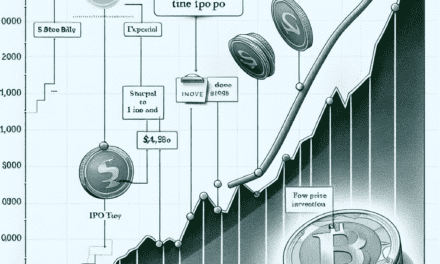“Balancing Act: Oil Prices Steady as Supply Tightens and Demand Wavers”
Introduction
Oil prices have reached a point of stabilization, navigating the complex interplay of supply constraints and fluctuating demand. This equilibrium comes after a period of volatility driven by geopolitical tensions, production cuts by major oil-producing nations, and the global economic recovery’s uneven pace. Supply-side factors, including OPEC+ production strategies and disruptions in key oil-producing regions, have played a significant role in shaping the current market landscape. Meanwhile, demand remains uncertain, influenced by varying rates of economic growth, energy transition policies, and the ongoing impact of the COVID-19 pandemic. As the market seeks balance, stakeholders are closely monitoring these dynamics to anticipate future price movements and their broader economic implications.
Impact Of Supply Constraints On Global Oil Prices
In recent months, the global oil market has experienced a period of stabilization, primarily driven by a complex interplay of supply constraints and fluctuating demand. This stabilization comes after a period of significant volatility, where prices were subject to rapid changes due to geopolitical tensions, economic recovery post-pandemic, and shifts in energy policies worldwide. The current state of the market reflects a delicate balance, with supply constraints playing a pivotal role in maintaining price levels.
Supply constraints have emerged as a critical factor influencing global oil prices. These constraints are largely the result of production cuts by major oil-producing nations, particularly those within the Organization of the Petroleum Exporting Countries (OPEC) and its allies, collectively known as OPEC+. In an effort to manage the global supply and stabilize prices, OPEC+ has implemented strategic production cuts. These measures have been instrumental in preventing an oversupply in the market, which could have led to a significant drop in prices. By carefully calibrating production levels, OPEC+ has managed to exert a stabilizing influence on the market, ensuring that prices remain within a desirable range.
Moreover, geopolitical factors have further exacerbated supply constraints. Political instability in key oil-producing regions, such as the Middle East and parts of Africa, has led to disruptions in production and export activities. These disruptions have contributed to a tighter supply, reinforcing the impact of OPEC+ production cuts. Additionally, sanctions on certain oil-producing countries have restricted their ability to export oil, further constraining global supply. These geopolitical dynamics underscore the vulnerability of the oil market to external shocks, highlighting the importance of stable political environments for maintaining consistent supply levels.
While supply constraints have played a significant role in stabilizing oil prices, demand uncertainty continues to pose challenges. The global demand for oil is influenced by a myriad of factors, including economic growth, technological advancements, and shifts in consumer behavior. The ongoing transition towards renewable energy sources and increased energy efficiency has led to a gradual decline in oil demand in some regions. However, emerging economies continue to exhibit robust demand growth, driven by industrialization and urbanization. This dichotomy in demand patterns creates an uncertain outlook for the oil market, as it remains unclear how quickly and extensively the global energy transition will unfold.
Furthermore, the lingering effects of the COVID-19 pandemic continue to impact oil demand. While many economies have shown signs of recovery, the pace and sustainability of this recovery remain uncertain. Fluctuations in economic activity, driven by potential resurgences of the virus and varying vaccination rates, contribute to the unpredictability of oil demand. Consequently, market participants remain cautious, closely monitoring economic indicators and adjusting their strategies accordingly.
In conclusion, the stabilization of oil prices amid supply constraints and uncertain demand reflects a complex and dynamic market environment. Supply constraints, driven by strategic production cuts and geopolitical factors, have played a crucial role in maintaining price levels. However, the uncertainty surrounding global oil demand, influenced by economic recovery and the energy transition, continues to pose challenges. As the world navigates these complexities, the oil market remains a focal point of global economic discourse, with stakeholders keenly observing developments that could impact future price trajectories.
Uncertain Demand: How It Influences Oil Market Stability
In recent months, the global oil market has experienced a period of relative stability, a development that has been influenced by a complex interplay of supply constraints and uncertain demand. This equilibrium, however, remains precarious, as the factors contributing to it are subject to rapid change. Understanding the role of uncertain demand in this context is crucial for comprehending the current state of the oil market and anticipating future trends.
To begin with, the demand for oil is inherently volatile, influenced by a myriad of factors ranging from economic growth rates to geopolitical tensions. In the current global landscape, economic recovery from the COVID-19 pandemic has been uneven, with some regions experiencing robust growth while others continue to struggle. This disparity has led to fluctuating demand for oil, as industrial activity and transportation needs vary significantly across different parts of the world. Moreover, the transition towards renewable energy sources and the increasing emphasis on sustainability have introduced an additional layer of uncertainty. As countries strive to meet their climate goals, the demand for fossil fuels, including oil, is expected to decline in the long term, although the pace of this transition remains uncertain.
In addition to these economic and environmental factors, geopolitical events continue to play a significant role in shaping oil demand. Political instability in key oil-producing regions can lead to sudden shifts in supply, which in turn affect demand dynamics. For instance, tensions in the Middle East or sanctions on major oil-exporting countries can disrupt supply chains, prompting fluctuations in oil prices. These geopolitical uncertainties contribute to the overall unpredictability of demand, as market participants must constantly adjust their expectations based on the latest developments.
Furthermore, technological advancements and changes in consumer behavior are also influencing oil demand. The rise of electric vehicles and improvements in energy efficiency are gradually reducing the reliance on oil for transportation. As more consumers and businesses adopt these technologies, the demand for oil is likely to decrease, albeit at a pace that is difficult to predict. This shift is compounded by changing consumer preferences, as individuals and companies increasingly prioritize sustainability and seek alternatives to traditional fossil fuels.
Despite these uncertainties, supply constraints have played a crucial role in stabilizing oil prices. OPEC and its allies, collectively known as OPEC+, have implemented production cuts to manage supply and support prices. These coordinated efforts have helped to offset some of the demand volatility, providing a degree of stability to the market. However, the effectiveness of these measures is contingent upon the ability of OPEC+ to maintain discipline among its members and respond swiftly to changing market conditions.
In conclusion, while oil prices have stabilized in recent months, the underlying factors contributing to this stability are fraught with uncertainty. The interplay between supply constraints and uncertain demand creates a delicate balance that could be disrupted by a range of economic, geopolitical, and technological developments. As the world continues to navigate these challenges, the oil market remains a dynamic and unpredictable environment. Stakeholders must remain vigilant and adaptable, ready to respond to shifts in demand and supply that could alter the current equilibrium. Understanding the nuances of uncertain demand is essential for anticipating future trends and making informed decisions in this ever-evolving market.
The Role Of OPEC In Stabilizing Oil Prices
In the complex world of global energy markets, the Organization of the Petroleum Exporting Countries (OPEC) plays a pivotal role in stabilizing oil prices, especially during periods marked by supply constraints and uncertain demand. As a consortium of oil-producing nations, OPEC’s influence extends beyond mere production quotas; it encompasses strategic decisions that can sway market dynamics and impact global economies. Understanding OPEC’s role in stabilizing oil prices requires an examination of its mechanisms, strategies, and the challenges it faces in a rapidly changing energy landscape.
OPEC’s primary tool for influencing oil prices is its ability to adjust production levels among its member countries. By coordinating output, OPEC can either increase supply to prevent prices from soaring or reduce production to support prices when they are falling. This balancing act is crucial, particularly when external factors such as geopolitical tensions, natural disasters, or technological advancements disrupt the equilibrium between supply and demand. For instance, during times of geopolitical instability in key oil-producing regions, OPEC’s decision to adjust production can mitigate potential price spikes, thereby providing a degree of stability to the market.
Moreover, OPEC’s role is not limited to reactive measures. The organization also engages in proactive strategies to anticipate market trends and prepare for future challenges. This involves analyzing global economic indicators, monitoring technological developments in alternative energy sources, and assessing the potential impact of environmental policies on oil demand. By staying ahead of these trends, OPEC can make informed decisions that help stabilize prices over the long term. This forward-thinking approach is essential in an era where the transition to renewable energy sources is gaining momentum, potentially altering the traditional dynamics of oil supply and demand.
However, OPEC’s ability to stabilize oil prices is not without its challenges. One significant hurdle is the diverse interests of its member countries, each with its own economic priorities and production capabilities. Reaching a consensus on production levels can be a complex negotiation process, as members must balance their national interests with the collective goal of market stability. Additionally, the rise of non-OPEC oil producers, particularly in North America, has introduced new variables into the equation. The increased production from these regions can offset OPEC’s efforts to control supply, necessitating more nuanced strategies to maintain influence over global oil prices.
Furthermore, the demand side of the equation presents its own set of uncertainties. Economic fluctuations, changes in consumer behavior, and shifts in energy policies can all impact oil demand, making it challenging for OPEC to predict and respond effectively. The COVID-19 pandemic, for example, led to an unprecedented drop in oil demand, prompting OPEC to implement significant production cuts to stabilize prices. Such events underscore the importance of flexibility and adaptability in OPEC’s approach to market stabilization.
In conclusion, OPEC’s role in stabilizing oil prices amid supply constraints and uncertain demand is multifaceted and dynamic. Through coordinated production adjustments, strategic foresight, and a keen understanding of global market trends, OPEC strives to maintain a balance that benefits both producers and consumers. However, the organization must continually navigate a landscape marked by diverse member interests, emerging competitors, and evolving demand patterns. As the world transitions towards a more sustainable energy future, OPEC’s ability to adapt and innovate will be crucial in ensuring its continued relevance and effectiveness in stabilizing oil prices.
Geopolitical Factors Affecting Oil Supply And Demand
In recent months, the global oil market has experienced a period of stabilization, a development that has been influenced by a complex interplay of geopolitical factors affecting both supply and demand. This stabilization comes after a period of significant volatility, where prices fluctuated due to a myriad of factors ranging from geopolitical tensions to economic uncertainties. As we delve into the geopolitical factors at play, it becomes evident that the current state of the oil market is shaped by a delicate balance of supply constraints and uncertain demand.
One of the primary geopolitical factors influencing oil supply is the ongoing tension in key oil-producing regions. For instance, the Middle East, a region that holds a substantial portion of the world’s oil reserves, continues to be a hotspot for geopolitical instability. Conflicts and political unrest in countries such as Iraq and Libya have led to disruptions in oil production, thereby constraining supply. Additionally, sanctions imposed on major oil producers like Iran and Venezuela have further tightened the global oil supply, as these countries struggle to maintain their production levels amidst economic and political pressures.
Moreover, the strategic decisions made by the Organization of the Petroleum Exporting Countries (OPEC) and its allies, collectively known as OPEC+, have played a crucial role in shaping the oil supply landscape. In an effort to manage the market and support prices, OPEC+ has implemented production cuts, which have contributed to the stabilization of oil prices. These cuts are often a response to the fluctuating demand and are aimed at preventing an oversupply that could lead to a significant drop in prices. However, the effectiveness of these measures is contingent upon the compliance of member countries, which can sometimes be inconsistent.
On the demand side, the global economic outlook remains uncertain, further complicating the dynamics of the oil market. The lingering effects of the COVID-19 pandemic continue to cast a shadow over economic recovery, with varying impacts on oil demand across different regions. In developed economies, the gradual return to pre-pandemic levels of industrial activity and transportation has bolstered demand. Conversely, in developing countries, where vaccination rates may be lower and economic recovery slower, demand remains subdued.
Furthermore, the transition towards renewable energy sources and the push for decarbonization have introduced an additional layer of complexity to the demand for oil. As countries strive to meet their climate goals, there is a growing emphasis on reducing reliance on fossil fuels, which could potentially dampen long-term demand for oil. However, this transition is not uniform across the globe, with some regions advancing more rapidly than others, thereby creating a patchwork of demand patterns.
In conclusion, the stabilization of oil prices is a reflection of the intricate balance between supply constraints and uncertain demand, both of which are heavily influenced by geopolitical factors. As the world navigates through these challenges, the oil market remains susceptible to sudden shifts, driven by geopolitical developments and economic changes. The interplay of these factors underscores the importance of monitoring geopolitical events and economic indicators, as they hold the key to understanding the future trajectory of oil prices. As such, stakeholders in the oil industry must remain vigilant and adaptable, ready to respond to the ever-evolving landscape of global oil supply and demand.
Future Projections: Will Oil Prices Remain Stable?
As the global economy continues to navigate the complexities of post-pandemic recovery, the oil market finds itself at a critical juncture. Recent trends indicate a stabilization of oil prices, a development that has captured the attention of industry analysts and policymakers alike. This stabilization is primarily attributed to a delicate balance between supply constraints and uncertain demand, both of which are influenced by a myriad of geopolitical and economic factors. Understanding whether this stability will persist requires a closer examination of these underlying dynamics.
To begin with, supply constraints have played a significant role in the current stabilization of oil prices. Key oil-producing nations, particularly those within the Organization of the Petroleum Exporting Countries (OPEC) and its allies, have maintained a cautious approach to increasing output. This strategy is largely driven by a desire to avoid the pitfalls of oversupply, which could lead to a precipitous drop in prices. Moreover, geopolitical tensions in major oil-producing regions, such as the Middle East and parts of Africa, have further restricted supply, adding a layer of complexity to the global oil market. These constraints have effectively created a floor for oil prices, preventing them from falling below certain levels.
On the demand side, the picture is less clear. While there has been a gradual recovery in global economic activity, the pace and sustainability of this recovery remain uncertain. Factors such as inflationary pressures, fluctuating consumer confidence, and the potential for new COVID-19 variants continue to cast a shadow over future demand for oil. Additionally, the ongoing transition towards renewable energy sources and the push for decarbonization in many countries are expected to have a long-term impact on oil consumption patterns. These elements contribute to a sense of unpredictability regarding future demand, which in turn influences price stability.
In light of these considerations, the question arises: will oil prices remain stable in the foreseeable future? The answer is contingent upon several interrelated factors. Firstly, the ability of oil-producing nations to manage supply effectively will be crucial. Should they succeed in maintaining a disciplined approach to production, it is likely that prices will remain relatively stable. However, any significant deviation from this strategy, whether due to internal disagreements or external pressures, could disrupt the current equilibrium.
Secondly, the trajectory of global economic recovery will play a pivotal role. A robust and sustained recovery would likely bolster demand for oil, potentially leading to upward pressure on prices. Conversely, any setbacks in economic growth could dampen demand and introduce volatility into the market. Furthermore, the pace of the energy transition will also be a determining factor. As countries continue to invest in renewable energy infrastructure and implement policies aimed at reducing carbon emissions, the demand for oil may gradually decline, exerting downward pressure on prices over the long term.
In conclusion, while oil prices have stabilized in recent times, the future remains fraught with uncertainties. The interplay between supply constraints and demand fluctuations will be critical in shaping the trajectory of oil prices. As such, stakeholders in the oil market must remain vigilant and adaptable, ready to respond to the evolving landscape. Only time will tell whether the current stability is a temporary respite or a harbinger of sustained equilibrium in the oil market.
Economic Implications Of Stabilized Oil Prices
The stabilization of oil prices, amid ongoing supply constraints and fluctuating demand, presents a complex landscape with significant economic implications. This equilibrium, while offering a semblance of predictability, is underpinned by a myriad of factors that continue to influence global markets. As oil prices stabilize, the economic ramifications are multifaceted, affecting everything from national economies to individual consumers.
To begin with, stabilized oil prices provide a degree of certainty for businesses and governments alike. For oil-producing countries, this stability can lead to more predictable revenue streams, allowing for better fiscal planning and economic forecasting. Countries heavily reliant on oil exports, such as those in the Middle East, can benefit from this predictability, potentially leading to more stable economic growth and the ability to invest in diversification efforts. Conversely, for oil-importing nations, stabilized prices can help in managing inflationary pressures, as energy costs are a significant component of overall inflation. This can lead to more stable consumer prices and potentially bolster economic growth by maintaining consumer purchasing power.
Moreover, the stabilization of oil prices can influence investment decisions within the energy sector. With prices no longer experiencing extreme volatility, energy companies may find it easier to plan long-term investments in both traditional and renewable energy sources. This could lead to increased capital expenditure in oil exploration and production, as well as in the development of alternative energy technologies. The transition to renewable energy sources is particularly crucial as the world grapples with the need to address climate change. Stable oil prices can provide the financial stability necessary for energy companies to invest in cleaner technologies, thus supporting global efforts to reduce carbon emissions.
However, the current stabilization is not without its challenges. Supply constraints, often resulting from geopolitical tensions or production cuts by major oil-producing nations, continue to pose a risk to this equilibrium. Any significant disruption in supply could lead to price spikes, which would have immediate and far-reaching economic consequences. Additionally, the demand side remains uncertain, influenced by factors such as global economic growth, technological advancements, and shifts in consumer behavior. The ongoing transition to electric vehicles and increased energy efficiency measures could dampen long-term demand for oil, adding another layer of complexity to the market dynamics.
Furthermore, the interplay between supply constraints and demand uncertainty can have broader economic implications. For instance, if supply constraints lead to higher prices, this could exacerbate inflationary pressures globally, prompting central banks to tighten monetary policy. Such actions could slow economic growth, affecting employment and investment levels. On the other hand, if demand weakens significantly, it could lead to an oversupply situation, putting downward pressure on prices and potentially leading to reduced investment in the energy sector.
In conclusion, while the stabilization of oil prices offers some economic benefits, it is essential to recognize the underlying complexities and potential risks. Policymakers and industry leaders must remain vigilant, continuously assessing the evolving landscape to mitigate potential disruptions. By understanding the intricate balance between supply constraints and demand uncertainties, stakeholders can better navigate the economic implications of stabilized oil prices, ensuring that both short-term stability and long-term sustainability are achieved.
Renewable Energy’s Influence On Oil Market Dynamics
In recent years, the global energy landscape has been undergoing a significant transformation, with renewable energy sources playing an increasingly pivotal role. This shift has had profound implications for the oil market, influencing both supply and demand dynamics. As oil prices stabilize amid ongoing supply constraints and uncertain demand, it is essential to examine how renewable energy is reshaping the oil market.
To begin with, the rise of renewable energy sources such as wind, solar, and hydropower has introduced a new dimension to the global energy mix. Governments worldwide are investing heavily in these technologies to reduce carbon emissions and combat climate change. This transition is gradually reducing the world’s reliance on fossil fuels, including oil. Consequently, the demand for oil is experiencing a shift, as industries and consumers alike turn to cleaner energy alternatives. This shift in demand is a critical factor contributing to the stabilization of oil prices, as it tempers the volatility traditionally associated with the oil market.
Moreover, the integration of renewable energy into the energy grid has led to increased energy efficiency and reduced consumption of oil-based products. For instance, the transportation sector, which has historically been a major consumer of oil, is witnessing a surge in electric vehicle adoption. This trend is further accelerated by advancements in battery technology and supportive government policies. As electric vehicles become more prevalent, the demand for gasoline and diesel is expected to decline, thereby exerting downward pressure on oil prices.
In addition to demand-side changes, renewable energy is also influencing the supply side of the oil market. The development of renewable energy infrastructure requires significant investment, which has, in some cases, diverted capital away from oil exploration and production. This shift in investment priorities can lead to supply constraints in the oil market, as new oil projects become less attractive to investors. Consequently, these supply constraints can contribute to the stabilization of oil prices, as reduced supply helps balance the market in the face of fluctuating demand.
Furthermore, the geopolitical landscape is also being reshaped by the rise of renewable energy. Countries that have traditionally been major oil exporters are now exploring ways to diversify their economies and reduce their dependence on oil revenues. This strategic shift is driven by the recognition that the global energy transition could diminish the long-term demand for oil. As these countries invest in renewable energy and other sectors, the global oil supply landscape is likely to evolve, with potential implications for oil prices.
Despite these transformative changes, it is important to acknowledge that the transition to renewable energy is a gradual process. Oil remains a critical component of the global energy system, and its role is unlikely to diminish overnight. However, the influence of renewable energy on the oil market is undeniable, as it introduces new dynamics that are reshaping the industry’s future.
In conclusion, the stabilization of oil prices amid supply constraints and uncertain demand can be attributed, in part, to the growing influence of renewable energy. As the world continues to embrace cleaner energy sources, the oil market will need to adapt to these changes. The interplay between renewable energy and oil will remain a key factor in determining the future trajectory of oil prices, as the global energy landscape continues to evolve.
Q&A
1. **Question:** What factors are contributing to the stabilization of oil prices?
– **Answer:** Oil prices are stabilizing due to a balance between supply constraints and uncertain demand. Supply constraints may arise from geopolitical tensions, production cuts by major oil-producing countries, or natural disasters affecting oil infrastructure. Uncertain demand is influenced by economic conditions, changes in energy consumption patterns, and shifts towards renewable energy sources.
2. **Question:** How do geopolitical tensions affect oil supply?
– **Answer:** Geopolitical tensions can lead to disruptions in oil supply by causing conflicts in key oil-producing regions, leading to sanctions, blockades, or damage to oil infrastructure, which in turn can reduce the availability of oil in the global market.
3. **Question:** What role do OPEC and other oil-producing countries play in oil price stabilization?
– **Answer:** OPEC and other oil-producing countries can influence oil prices by adjusting their production levels. By coordinating production cuts or increases, they can manage supply to stabilize prices, especially during periods of fluctuating demand.
4. **Question:** How does economic uncertainty impact oil demand?
– **Answer:** Economic uncertainty can lead to reduced industrial activity and consumer spending, which decreases the demand for oil. This can be due to factors such as recessions, inflation, or changes in government policies affecting energy consumption.
5. **Question:** What are some potential consequences of prolonged oil price stabilization?
– **Answer:** Prolonged oil price stabilization can lead to reduced investment in oil exploration and production, as companies may find it less profitable. It can also impact government revenues in oil-dependent economies and influence global energy transition strategies.
6. **Question:** How might shifts towards renewable energy sources affect future oil demand?
– **Answer:** As more countries and companies invest in renewable energy sources, the demand for oil may decrease over time. This shift can lead to a long-term reduction in oil consumption, affecting prices and the global energy market dynamics.
7. **Question:** What are some strategies that oil companies might adopt in response to stabilized oil prices?
– **Answer:** Oil companies might focus on cost reduction, diversification into renewable energy, investment in technology to improve efficiency, and strategic partnerships to maintain profitability and adapt to changing market conditions.
Conclusion
Oil prices have recently stabilized due to a complex interplay of supply constraints and uncertain demand dynamics. On the supply side, geopolitical tensions, production cuts by major oil-producing nations, and disruptions in key regions have limited the availability of crude oil, contributing to upward pressure on prices. Conversely, demand uncertainty, driven by fluctuating economic conditions, shifts in energy consumption patterns, and the ongoing transition to renewable energy sources, has tempered price increases. This balance between constrained supply and unpredictable demand has led to a stabilization of oil prices, reflecting the market’s adaptation to these evolving factors. As the global economy continues to navigate these challenges, the oil market remains sensitive to any changes in supply and demand dynamics, which could lead to future volatility.





